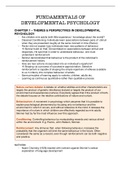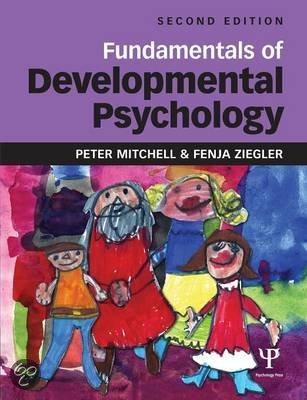FUNDAMENTALS OF
DEVELOPMENTAL PSYCHOLOGY
CHAPTER 1 – THEMES & PERSPECTIVES IN DEVELOPMENTAL
PSYCHOLOGY
- Are children mini adults (with little experience / knowledge about the world)?
- Classical Conditioning: Individuals learn associations between pairs of stimuli
when they are presented roughly at the same moment in time (Pavlov).
- Pavlov did not explain how individuals learn new patterns of behaviour
à Skinner build on that, concentrated on associations between stimuli and
responses. He said that in order to understand behaviour, one must
understand reinforcement
- Skinner demonstrated that behaviour is the product of the individual’s
reinforcement history
- How are new actions incorporated into an individual’s repertoire?
à Shaping via a process of successive approximation. Selective
reinforcement is capable of shaping the simple repertoire of reflexes available
to us in infancy into complex behaviour of adults
- Same principles of learning apply to rodents, children, adults etc.
- Learning as continuous quantitative rather than qualitative process
Nature-nurture debate: A debate on whether abilities and other characteristics are
largely the product of genetic inheritance (nature) or largely the product of our
environment and experiences (nurture). Everybody agrees that it the product of both,
the debate focuses on the relative contributions of nature and nurture.
Behaviourism: A movement in psychology which assumes that it is possible to
explain psychological phenomena by focusing only on behaviour and the
environment in which it occurs, and without reference to the mind. It stresses the
importance of nurture in which children are effectively regarded as mini adults.
Skinner had by far the most influence over this approach.
Conditioning: Controlling behaviour by manipulating rewards and various stimuli
within the environment. E.g. Pavlov, John Watson, Skinner.
Reinforcement: Any stimulus that, when following behaviour, increases the
probability that the organism will emit the same behaviour in the future. Often
considered the same as a reward, even though reinforcement can be both negative
and positive.
NATIVISM
- Noam Chomsky (1928) reacted with nativism against Skinner’s radical
explanation of language development
, - Saw paradox in infants learning to speak despite being subjected to a
grammatically degraded input of language à how to infants learn a complex
language when they have less intellectual capacity than adults?
- Suggested infants are born with innate knowledge of language (on a general
level, not language specific) à that means all languages have something in
common (deep structure) = when we interpret language, we do so by
translating into the deeps structure
- As a linguist, Chomsky lad emphasis on innate capacities in the sphere of
learning language à role of innate processes in other capacities (motivation,
intelligence, personality etc.)?
- Leaned towards nature, still saw infants as mini adults (thinking / processing
is initially the same for adults and children)
MATURATION AND ETHOLOGY
- Innate characteristics don’t automatically develop themselves at birth (we
have the innate drive to walk, still children don’t walk for at least 1 year)
à dormant innate characteristics that unfolds as results from maturational
unfolding (doesn’t have to depend on learning or experience)
- The maturational view is seated within the nativist tradition and rejects the
notion of babies as mini adults
- Maturation could have an effect in at least 2 ways
1. The capacity (for walking etc.) unfolds maturationally, almost in-
dependently of experience and learning
2. Readiness to learn – like a device under the control of the maturational
clock, that makes it easier for us to learn a language at 18 months than at
12 month = biologically prepared to learn language
Deep structure: An innate grammatical structuring of language that is both
universal among humans and unique to humans as a species (Chomsky).
Innate: An ability or trait that is with us from birth.
Maturational unfolding: A genetically determined developmental progression.
There are maturational stages, that transform the individual step by step from
being a baby to being an adult.
Biological preparedness: A genetically determined readiness to learn specific
skills, such as how to walk. Remains speculative.
Ethology: The study of animals in their natural habitat.
- Many of the actual details of language learning remain speculative
à attachment as more informative possibility
- Children and animals are automatically attached to their parents (the first
conspicuous moving object they see at birth, 10-30h after birth, Konrad
Lorenz). Once the attachment is formed, the learning capacity is switched off
à biological preparedness / maturational clock / critical period of time
, - Bowlby: Same attachment behaviour in humans, just different time scale
(from 8-9 months babies show strong reaction to mother leaving the room)
- Not having the opportunity to form any attachment has devastating effect on
the baby’s development (physically, intellectually and emotionally delays)
- The concepts of maturation and biological preparedness help us to
understand how innate factors combine with learning and experience as a
driving force of development. Learning is steered by innate processes and the
timing of this steer is maturationally determined
- Innate factors combine with learning and experience in allowing the individual
to achieve developmental milestones à qualitative differences
= baby is not a mini adult
STAGE THEORIES – FREUD AND PIAGET
- Stages theories maintain that children undergo succession of psychological
metamorphoses / stages on their way to adulthood. These stages can be
understood as product of the combined influence of innate factors
(maturation, biological preparedness) and experiential factors (associated
with learning opportunities and characteristics of the environment)
- Freud was one of the first stage theorists. Wanted to explain personality
development and suggested that it largely depend of sexual fixations / focal
erogenous zone of each stage
- Piaget, inspired by Freud, developed another stage theory à preeminent in
developmental psychology, radical influence on the discipline
- Become cognitive developmentalist, focussing on the nature of intelligence
- Suggested that children pass through a series of stages on the way to
adulthood, whereby cognitive development is not a continuous process, but
dependent upon the accumulation of information and skills
à proceeds not by gradual evolution, but by cognitive revolution
- When children shift onto new “stage” of more sophisticated intelligence, it
sheds several of the old cognitive limitations at once. Therefore a child is not
a mini adult (they don’t have the same thought processes as adults)
- Intelligence is a faculty whose purpose is to help us adjust to the environment
- Environment is broadly divided into two
1. Human, social or psychological environment
2. Physical environment
à adjustment to both kinds is very important
- According to Piaget a singular factor stands in the way of good adjustment
Egocentrism: Difficulty taking on board another person’s perspective,
because they see the world from their own viewpoint and setting that
Egocentrism is In early childhood In middle In adolescence
STAGE 1
STAGE 2
STAGE 3
STAGE 4
the most severe the severy childhood the the individual can
egocentrism is shed
during infancy. and the child individual break free and
Infant cant understands it's overcomes the imagine how
distinguish different from the subtle things might have
between the rest as the world (still egocentrism, but been different
subjective and mild egocentrism, is still mentally depending on
finds it difficult to
the objective. acknowledge that trapped in the key events in
own reality is here and now. history.
restricted to their
viewpoint)
, particular viewpoint aside is only achieved as a monumental intellectual feat
à only possible through a series of stages
à If Piaget is right, that would have severe implications for education
- He did not believe that the stages were maturational = stage theorist, without
being a maturationist
- Knowledge is built stage by stage, where each not only serves as a good
adaptation, but also provides a foundation for the next stage
Constructivism: A theory that knowledge is actively generated by the individual
generated by the individual rather than transmitted by another person or
through one’s genes.
CHAPTER 2 – METHODOLOGICAL APPROACHES
- How does the mind work and develop over the period spanning childhood?
- Behaviourists such as skinner opposed psychoanalysis and the concept of
the “mind” as not measurable and not scientific enough
- Measurements made / techniques must be adapted to the specific age
DEVELOPMENTAL COGNITIVE NEUROSCIENCE
- The idea that our understanding of the mind can be informed by discoveries
of the structure and form of the brain (based on imaging techniques)
- MRI (magnetic resonance imaging) generate high-resolution images of the
brain. The images are offered in 2 general forms
o Structural MRI: Snapshot of virtual “slices” of the brain, working from
the top to the bottom enables us to create 3D images
o Functional MRI (fMRI): Gives an image of how areas of activity change
within the brain over time, detects concentrations of blood à allows to
find out what areas of the brain are responsible for which processes.
All of the areas of the brain are supplied by blood at all times, needs to
be taken into consideration when designing the experiment.
- EEG (electroencephalogram) is another brain imagining techniques. The
electrodes are capable of picking up minute electromagnetic activity by the
electro-chemical processes occurring at the surface of the cortex of the
brain. Not as precise as MRI in telling us where activity is located, but more
accurate in how neural activity changes over a very brief period of time. When
the participant receives a stimulus, this evokes a characteristic cortical
response, which will then decay over ensuring milliseconds à provides
valuable information about attention at the level of the cortex, especially the
speed of shifts in attention (e.g. patterns in autism)
- Brain imaging helps us understand how cognitive function is represented in
the architecture of the brain
- How is that knowledge valuable? Evolutionary evolves higher cognitive
abilities, as well as executive functions, some aspects of language and





